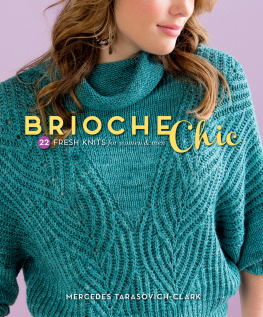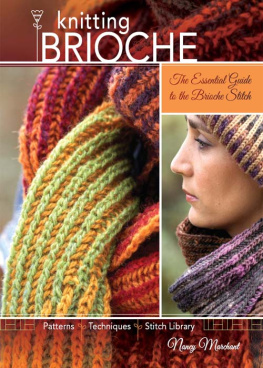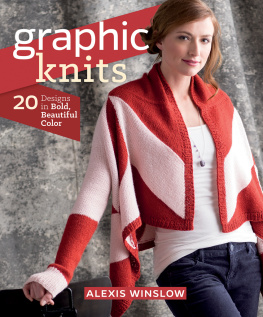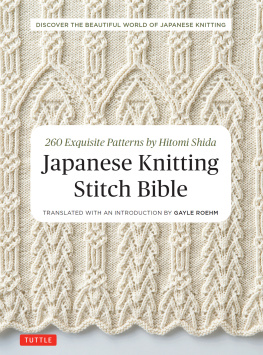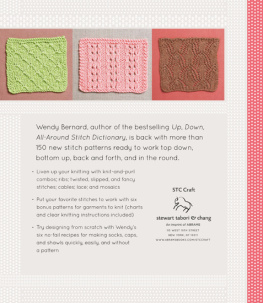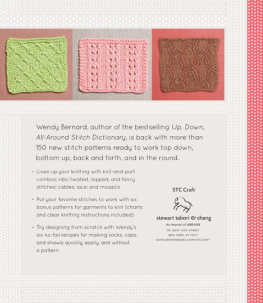Thank you for purchasing this Martha Pullen eBook.
Sign up for our newsletter and receive special offers, access to free content, and information on the latest new releases and must-have crafting resources! Plus, receive a coupon code to use on your first purchase from Store.MarthaPullen.com for signing up.
or visit us online to sign up at
http://marthapullen.com/ebook-promo
Knitting Brioche: The Essential Guide to the Brioche Stitch. Copyright 2009 by Nancy Marchant. Manufactured in the United States. All rights reserved. The patterns and drawings in the book are for personal use of reader. By permission of the author and publisher, they may be either hand-traced or photocopied to make single copies, but under no circumstances may they be resold or republished. No other part of this book may be reproduced in any form or by any electronic or mechanical means including information storage and retrieval systems without permission in writing from the publisher, except by a reviewer, who may quote a brief passage in review. Published by North Light Books, an imprint of F+W Media, Inc., 4700 East Galbraith Road, Cincinnati, Ohio 45236. (800) 289-0963. First edition.
13 12 11 10 09 5 4 3 2 1
Distributed in Canada by Fraser Direct
100 Armstrong Avenue
Georgetown, ON, Canada L7G 5S4
Tel: (905) 877-4411
Distributed in the U.K. and Europe by David & Charles
Brunel House, Newton Abbot, Devon, TQ12 4PU, England
Tel: (+44) 1626 323200, Fax: (+44) 1626 323319
E-mail:
Distributed in Australia by Capricorn Link
P.O. Box 704, S. Windsor, NSW 2756 Australia
Tel: (02) 4577-3555
Library of Congress Cataloging-in-Publication Data
Marchant, Nancy
Knitting brioche: the essential guide to the brioche stitch / Nancy Marchant. 1st ed.
p. cm.
Includes bibliographical references and index.
ISBN 978-1-60061-301-2 (alk. paper)
1. KnittingPatterns. 2. KnittingNetherlands. I. Title.
TT825.M267 2009
746.432041dc22
2009038643

ON THE COVER
LEFT: GEVELDAK SCARF (PAGE 193)
RIGHT: WINDMILL BRIOCHE BERET (HTTP://WWW.BRIOCHESTITCH.COM/P_FBP.HTM)) AND BEBEB SCARF (MADE USING TWO-COLOR BRIOCHE STITCH WITH A SELVEDGE EDGEODD NUMBER OF STITCHES [PAGE 68] AND FOUR SKEINS OF NORO KUREYON)
EDITOR JENNIFER CLAYDON
PHOTOGRAPHERS CHRISTINE POLOMSKY AND FREEK ESSER
PRODUCTION COORDINATOR GREG NOCK TECHNICAL EDITOR SUE MCCAIN
dedication
I would like to dedicate this book to my mother and my children. Thanks Mom, for teaching me how to knit, and thanks Mathilde and Rosalie, for allowing me to continue.
acknowledgments
I would like to thank Ans Siemens who has been my faithful knitter and friend for the last thirty years. She never failed to correct my mistakes, make useful suggestions concerning the patterns and knit at record speed. Ans knit most of the large sweater pieces. Thanks to Alex Richardson for knitting the Bloemenvelden Scarf and Malia Mather for knitting the sleeves for The Book Exchange Cardigan. Thanks to Mimi Jaffr for teaching me the different methods of the patentsteek.
Thanks to the models/stylists Lytri Smit and Charlotte Buhler, the models Majken Smit, Mats Smit, Joost Geijsen and Laura Duisdeiker. Thanks to Wilma Scholte for make-up and a special thanks to Freek Esser, the photographer. Your combined efforts made this book beautiful. Thanks to Sue McCain for tech editing. Thanks to Jessica Gordon for initially asking me to write the book and to Jennifer Claydon who had the difficult job of editing it.
Thanks to Jean Dunbabin of Cascade Yarns and Linda Pratt of Westminster Fibers for providing yarns.
Thanks to Mark and Coleen Davis-Stanton for buying so many of my sweaters when my funds were low.
Thanks to Veda and Theresa for being my friends.
Thanks to all of the Stones and Marchants for encouraging me to pursue my dreams.
about the author

Nancy Marchant first discovered brioche stitch when she moved to the Netherlands in 1976. She became fascinated with brioche knitting and wrote about it in Vogue Knitting Magazine, as well as in a number of other knitting magazines. She maintains a Web site on the subject at www.briochestitch.com and teaches brioche knitting both locally and at large yarn shows.
about the photographer

Freek Esser is Dutch and was born in Indonesia. He worked as an assistant to Irving Penn for two years and now works freelance, mainly for travel, fashion and interior design magazines. His Web site is www.freekesser.nl.
table of contents

introduction
I was born and raised in Evansville, Indiana, and was educated in Bloomington, Indiana, and Berkeley, California. In 1976, I moved to the Netherlands. It was there that I learned about the patentsteek. It was a very common stitch and experienced Dutch knitters knew four different methods for producing it.
As I began researching its history, I found that, among English-speaking knitters, this stitch also had many different names; Prime Rib, Shawl Stitch, Oriental Rib, English Rib, Shaker Knitting, Patent Stitch, Fishermans Rib and Brioche Stitch were among them.
In her book, A Treasury of Knitting Patterns, Barbara G. Walker calls the patentsteek stitch Brioche Stitch when it is worked with a slipped stitch and yarn over. And so it came to be called in an article I wrote for Vogue Knitting Magazine (Winter 1992-93) in which I described the stitch, tried to create a new set of abbreviations and nomenclature for the stitch, and showed a few variations.
The diversity of brioche stitch does not end with its many names or various modes of production. Experimenting with the design elements of line and color through brioche knitting reveals new and exciting variations.
In 2005, I wrote a second article about brioche stitch for Interweave Knits Magazine (Spring issue) because I wanted to introduce a deeper study of playing with the linear quality of this stitch.
This book is an extension of my experimentation with brioche stitch.
Nancy Marchant
about brioche knitting
A Brief History of Brioche Knitting
During the mid-1800s in England, needlework periodicals and books frequently featured patterns for brioches, which were cushions or footstools that were popular at the time. The first brioche stitch knitting pattern that I could find written in English was Moorish Brioche or Cushion, written by Miss Watts in her book,




